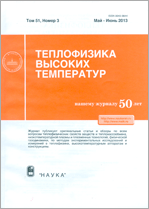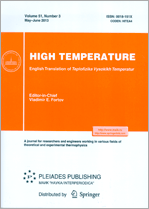|
This article is cited in 11 scientific papers (total in 11 papers)
Heat and Mass Transfer and Physical Gasdynamics
Extreme focusing of energy during shock compression of the vapor bubble in hydrocarbon liquids
R. I. Nigmatulinab, A. A. Aganinac, M. A. Il'gamovac, D. Yu. Toporkova
a Research Institute of Mechanics and Machinery of Kazan Scientific Center of the Russian Academy of Sciences
b P. P. Shirshov Institute of Oceanology, Russian Academy of Sciences
c Mavlyutov Institute of Mechanics, Ufa Centre of the Russian Academy of Sciences
Abstract:
In this paper, we compare the features of the shock compression of $1$-mm vapor bubbles and the nonsphericity growth during their collapse in hydrocarbon (acetone, benzol, and tetradecane) liquids. At the beginning of compression, the vapor is in a saturation state at $1.03$ MPa, and the bubble collapse is caused by a liquid pressure of $5$ MPa. It has been found that, during the collapse of the bubble in acetone, only weak compression waves occur in its cavity, while intense, radially convergent compression waves that transform into shock waves arise in the bubbles in benzol and tetradecane, which have a significantly greater molecular weight and, consequently, a lower speed of sound in the vapor. This leads to an extreme focusing of energy at the bubble center. A shock wave in tetradecane appears shortly after the onset of collapse, whereas a shock wave in benzol forms only during the reconvergence of the unstressed compression wave to the center of the bubble after its reflections from the center and the interface. As a result, the highest values of thermodynamic parameters are attained in tetradecane, while the lowest values are achieved in acetone. The bubble nonsphericity is shown to increase by two orders of magnitude less in tetradecane than in acetone and benzol by the time it reaches the extreme values of the thermodynamic parameters.
Received: 18.01.2018
Accepted: 10.10.2018
Citation:
R. I. Nigmatulin, A. A. Aganin, M. A. Il'gamov, D. Yu. Toporkov, “Extreme focusing of energy during shock compression of the vapor bubble in hydrocarbon liquids”, TVT, 57:2 (2019), 253–261; High Temperature, 57:2 (2019), 228–235
Linking options:
https://www.mathnet.ru/eng/tvt10993 https://www.mathnet.ru/eng/tvt/v57/i2/p253
|


| Statistics & downloads: |
| Abstract page: | 312 | | Full-text PDF : | 141 | | References: | 33 |
|





 Contact us:
Contact us: Terms of Use
Terms of Use
 Registration to the website
Registration to the website Logotypes
Logotypes








 Citation in format
Citation in format 
